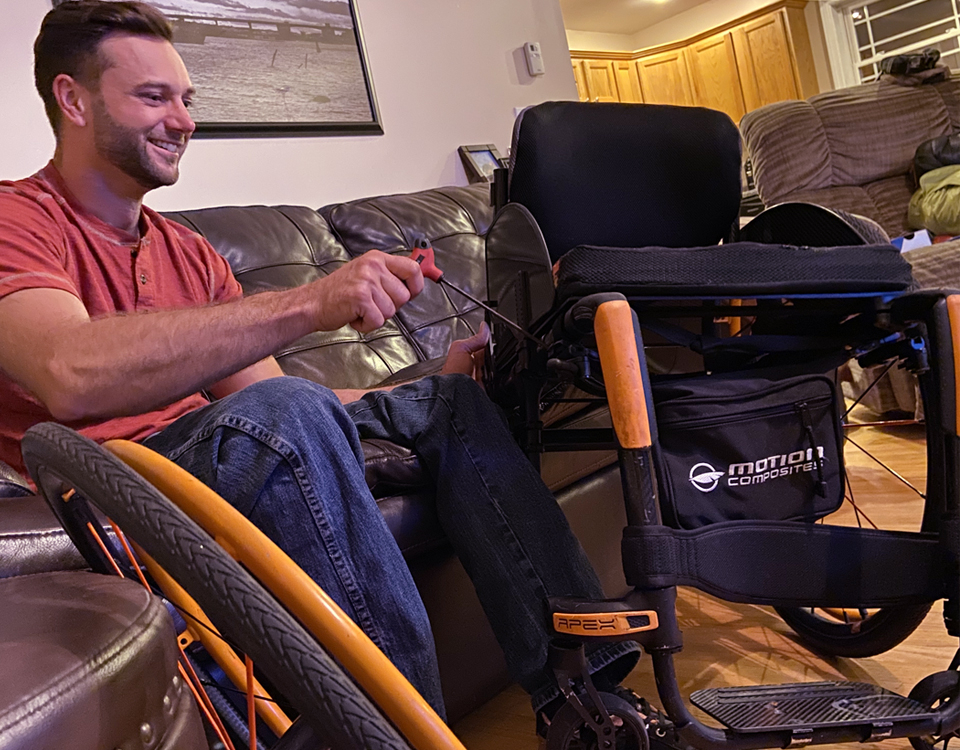Maintaining your Manual Wheelchair for Top Performance
What does “Regular Maintenance” look like for a manual wheelchair? Regardless if the owner or caregiver is performing it, having a plan and completing routine maintenance is a necessity.
What does “Regular Maintenance” look like for a manual wheelchair? Regardless if the owner or caregiver is performing it, having a plan and completing routine maintenance is a necessity.
*Written in collaboration with:
Todd Richardson, ATP, Eastern Regional Sales Manager Motion Composites
Chris Collin, North East Sales Manager Motion Composites
Just like preventative maintenance for a vehicle keeps it running and in top performance, the same is true for a manual wheelchair. Don’t assume it is the responsibility of the provider.
A custom ultralightweight manual wheelchair, while often paid for by a third-party funding source, insurance or government entity, is a large investment in mobility and should be maintained with care. Because most clients don’t have access to unlimited funding to get new equipment at will, taking steps to keep the chair well maintained will keep it in top performance for years.
Motion Composites Eastern US Regional Manager Todd Richardson, who has used a manual wheelchair for over 30 years and worked as an ATP, shared some tips on how he keeps his manual chair in optimum condition.
“Number one recommendation is to keep the wheelchair clean all the time. I wanted to inspire clients to look at their chairs as an extension of themselves. By keeping the chair extremely clean, and looking at the chair daily, it allows the user to catch small issues before they turn into large problems.” Todd recommends not waiting until something falls off the chair before looking for a tool to fix or tighten it. “As soon as you know its loose, take care of it. Keep everything tight, no rattling, because as soon as it begins to loosen and the client rides in it, it will never be as tight or perform as it had previously.”
Todd’s charge is to present the chair as an extension of the user. By keeping the chair clean and well maintained, it will always be in best shape, and never left in disrepair.
Chris Collin, North East Sales Manager Motion Composites says, “Maintenance is climate dependent, understanding how it affects the materials in the wheelchair is important for best performance.” He also reiterated the importance of keeping the chair clean and paying attention all the small details, especially air pressure in the tires. Since Chris lives in New England, his chair is subject to a variety of weather conditions that can impact the chair and components over time.
Be sure to use non-abrasive cleaners and follow instructions in the manufacturer’s owner’s manual for specifics. If you have misplaced your user’s manual, they are available on your manufacturer’s website. For Motion Composites product, you’ll find this information in our Tools and Forms section.
To get started, if you follow these general recommendations the manual wheelchair should remain in top condition for some time:
|
Daily Maintenance Recommendations |
Wipe off any visual dirt and debris and clean Ensure parts are in working order and engaged properly, especially wheel locks |
|
Weekly Maintenance Recommendations |
Disinfect wheelchair as needed Check tire pressure and inflate if needed Check wheel locks |
|
Monthly Maintenance Recommendations |
Remove hair from casters Inflate tires if needed Check all hardware, tighten as needed |
|
Quarterly Maintenance Recommendations |
Check wheel locks after inflating tires Free spin all wheels and casters to check bearings Clean all parts while performing thorough maintenance Check cushion and backrest including padding/hardware/covers |
|
Yearly Maintenance Recommendations |
Have wheelchair inspected by qualified technician |
If at any time something loosens, begins to make a noise, or otherwise seem out of place, check it out immediately, don’t let something small and annoying turn into something catastrophic. Caregivers or clients should contact a provider if unable to resolve issue themselves or with use of manufacturer’s user’s manual.
